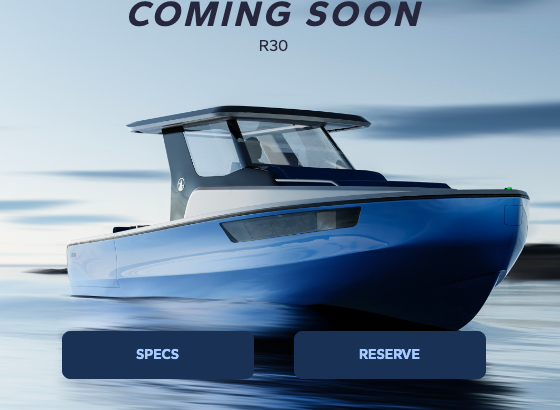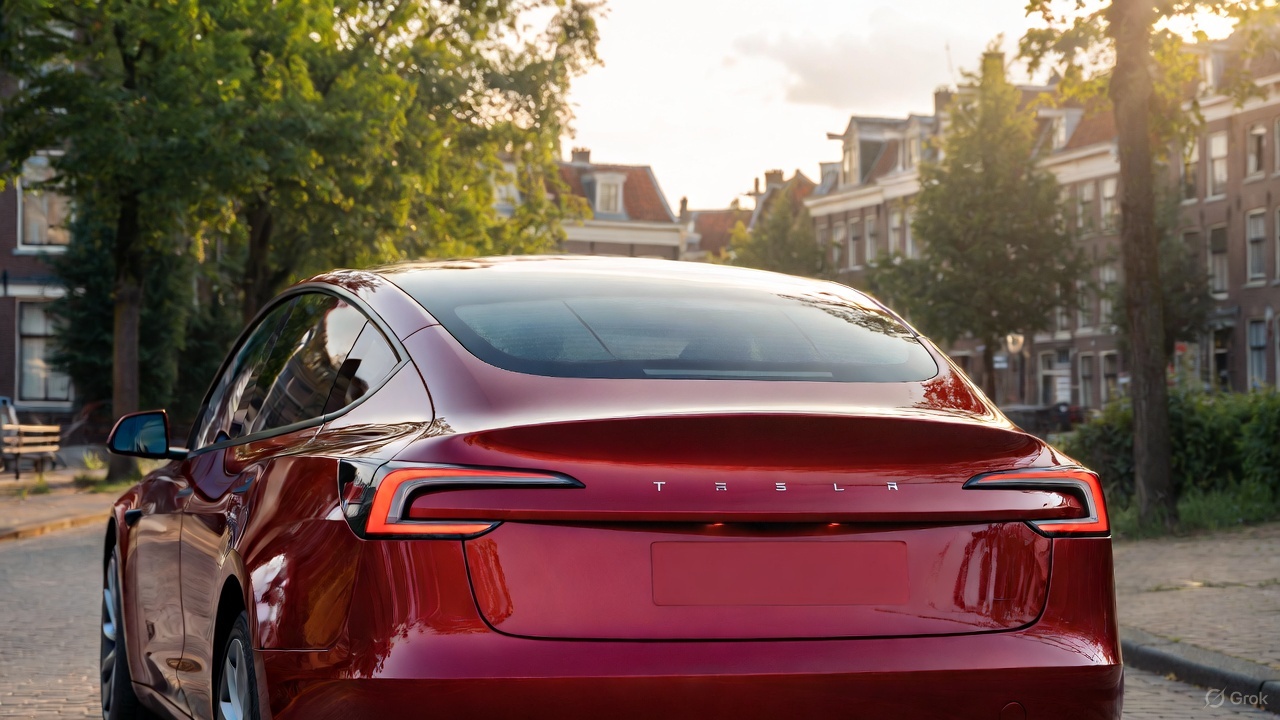

News
Exclusive interview: Former Tesla exec launches 800 hp electric boat; says it’s an extension of Tesla’s mission
Former Tesla Head of Global Manufacturing, Jonathan Vo, is launching the R30, a 30-foot all-electric power boat with 800 horsepower, dual motors, and solar charging. In 2022, he founded Blue Innovations Group (BIG), which focuses on the manufacturing of all-electric boats and sustainable marine technologies.
BIG plans to manufacture its products at its facility in Pinellas Park, Florida, and will demonstrate its technology at the upcoming Consumer Electronics Show (CES) in Las Vegas, Nevada, which will take place from January 5th through the 8th of next year.
Teslarati spoke with Vo, who said his mission was an extension of Tesla’s mission. He said that the R30 was designed to be versatile and comfortable for the whole family. He explained that based on the frequency of how boats are used, it is designed to be “a truly sustainable energy power boat.”
“The R30 is a fully electric sustainable boat with a large solar system on it with up to 2.7-kilowatt–you’re probably going to have a pretty decent amount of charge if not full,” Vo said.
He added it was designed for the work-life balance for the entire family. “You can have privacy, office capabilities, and activities on and off the boat, such as fishing and diving.”
“We designed the boat to encompass the entire family dynamic.”
Teslarati asked Vo what inspired him to go into electric boats. He noted that while at Tesla, he didn’t know much about cars and that it was a learning experience and a success for his career.
Vo’s background before joining Tesla was in semiconductor, solar, and aerospace. A friend working at Tesla invited him to work.
“It was out of curiosity and helping a friend that I came to Tesla. I didn’t know anything about cars. I actually came to Tesla to work on batteries. I ended up moving to cars.”
“It turned out pretty good. To me, in my career, I have two choices. Either a success experience or a learning experience, and Tesla was one of those special ones that were both successful and learning”
Vo noted that when he began working at Tesla, some of his peers kind of joked since electric cars weren’t too familiar during that time. He added that Tesla’s impact on EVs was huge on the industry and changed how people think about the automotive industry.
“Not just automotive but the new level of expectations of what the car should do. Before Tesla, we didn’t talk about autonomous driving or about over-the-air connecting or software. Tesla raised the expectation.”
It was his work at Tesla that inspired him to take that same outlook on electric boats.
“Electric cars make a lot of sense, and electric boats are a no-brainer. Boats are ten times less efficient than cars.”
He added that boats have a higher maintenance cost than cars and his background at Tesla inspired him to eliminate this problem from the boating industry.
“If we can make the boat reliable and eliminate the cost of repairs and fuel consumption, it’s a no-brainer.”
He added that, eventually, more humans would turn to boats as the population grows. The earth is 70% water, so it makes sense to solve this problem.
“I think it’s just a matter of time before we will have to move to water, and we need to make sure if we move to that, that the solution is sustainable and ready for it. I think that is what makes our mission critical. It’s important to do that. And we have the skill set and experience to enable that.”
Disclosure: Johnna is a $TSLA shareholder and believes in Tesla’s mission.
Your feedback is welcome. If you have any comments or concerns or see a typo, you can email me at johnna@teslarati.com. You can also reach me on Twitter at @JohnnaCrider1.
Teslarati is now on TikTok. Follow us for interactive news & more. Teslarati is now on TikTok. Follow us for interactive news & more. You can also follow Teslarati on LinkedIn, Twitter, Instagram, and Facebook.

Elon Musk
Tesla CEO Elon Musk sends rivals dire warning about Full Self-Driving

Tesla CEO Elon Musk revealed today on the social media platform X that legacy automakers, such as Ford, General Motors, and Stellantis, do not want to license the company’s Full Self-Driving suite, at least not without a long list of their own terms.
“I’ve tried to warn them and even offered to license Tesla FSD, but they don’t want it! Crazy,” Musk said on X. “When legacy auto does occasionally reach out, they tepidly discuss implementing FSD for a tiny program in 5 years with unworkable requirements for Tesla, so pointless.”
I’ve tried to warn them and even offered to license Tesla FSD, but they don’t want it! Crazy …
When legacy auto does occasionally reach out, they tepidly discuss implementing FSD for a tiny program in 5 years with unworkable requirements for Tesla, so pointless. 🤷♂️
🦕 🦕
— Elon Musk (@elonmusk) November 24, 2025
Musk made the remark in response to a note we wrote about earlier today from Melius Research, in which analyst Rob Wertheimer said, “Our point is not that Tesla is at risk, it’s that everybody else is,” in terms of autonomy and self-driving development.
Wertheimer believes there are hundreds of billions of dollars in value headed toward Tesla’s way because of its prowess with FSD.
A few years ago, Musk first remarked that Tesla was in early talks with one legacy automaker regarding licensing Full Self-Driving for its vehicles. Tesla never confirmed which company it was, but given Musk’s ongoing talks with Ford CEO Jim Farley at the time, it seemed the Detroit-based automaker was the likely suspect.
Tesla’s Elon Musk reiterates FSD licensing offer for other automakers
Ford has been perhaps the most aggressive legacy automaker in terms of its EV efforts, but it recently scaled back its electric offensive due to profitability issues and weak demand. It simply was not making enough vehicles, nor selling the volume needed to turn a profit.
Musk truly believes that many of the companies that turn their backs on FSD now will suffer in the future, especially considering the increased chance it could be a parallel to what has happened with EV efforts for many of these companies.
Unfortunately, they got started too late and are now playing catch-up with Tesla, XPeng, BYD, and the other dominating forces in EVs across the globe.
News
Tesla backtracks on strange Nav feature after numerous complaints

Tesla is backtracking on a strange adjustment it made to its in-car Navigation feature after numerous complaints from owners convinced the company to make a change.
Tesla’s in-car Navigation is catered to its vehicles, as it routes Supercharging stops and preps your vehicle for charging with preconditioning. It is also very intuitive, and features other things like weather radar and a detailed map outlining points of interest.
However, a recent change to the Navigation by Tesla did not go unnoticed, and owners were really upset about it.
For trips that required multiple Supercharger stops, Tesla decided to implement a naming change, which did not show the city or state of each charging stop. Instead, it just showed the business where the Supercharger was located, giving many owners an unwelcome surprise.
However, Tesla’s Director of Supercharging, Max de Zegher, admitted the update was a “big mistake on our end,” and made a change that rolled out within 24 hours:
The naming change should have happened at once, instead of in 2 sequential steps. That was a big miss on our end. We do listen to the community and we do course-correct fast. The accelerated fix rolled out last night. The Tesla App is updated and most in-car touchscreens should…
— Max (@MdeZegher) November 20, 2025
The lack of a name for the city where a Supercharging stop would be made caused some confusion for owners in the short term. Some drivers argued that it was more difficult to make stops at some familiar locations that were special to them. Others were not too keen on not knowing where they were going to be along their trip.
Tesla was quick to scramble to resolve this issue, and it did a great job of rolling it out in an expedited manner, as de Zegher said that most in-car touch screens would notice the fix within one day of the change being rolled out.
Additionally, there will be even more improvements in December, as Tesla plans to show the common name/amenity below the site name as well, which will give people a better idea of what to expect when they arrive at a Supercharger.
News
Dutch regulator RDW confirms Tesla FSD February 2026 target
The regulator emphasized that safety, not public pressure, will decide whether FSD receives authorization for use in Europe.

The Dutch vehicle authority RDW responded to Tesla’s recent updates about its efforts to bring Full Self-Driving (Supervised) in Europe, confirming that February 2026 remains the target month for Tesla to demonstrate regulatory compliance.
While acknowledging the tentative schedule with Tesla, the regulator emphasized that safety, not public pressure, will decide whether FSD receives authorization for use in Europe.
RDW confirms 2026 target, warns Feb 2026 timeline is not guaranteed
In its response, which was posted on its official website, the RDW clarified that it does not disclose details about ongoing manufacturer applications due to competitive sensitivity. However, the agency confirmed that both parties have agreed on a February 2026 window during which Tesla is expected to show that FSD (Supervised) can meet required safety and compliance standards. Whether Tesla can satisfy those conditions within the timeline “remains to be seen,” RDW added.
RDW also directly addressed Tesla’s social media request encouraging drivers to contact the regulator to express support. While thanking those who already reached out, RDW asked the public to stop contacting them, noting these messages burden customer-service resources and have no influence on the approval process.
“In the message on X, Tesla calls on Tesla drivers to thank the RDW and to express their enthusiasm about this planning to us by contacting us. We thank everyone who has already done so, and would like to ask everyone not to contact us about this. It takes up unnecessary time for our customer service. Moreover, this will have no influence on whether or not the planning is met,” the RDW wrote.
The RDW shares insights on EU approval requirements
The RDW further outlined how new technology enters the European market when no existing legislation directly covers it. Under EU Regulation 2018/858, a manufacturer may seek an exemption for unregulated features such as advanced driver assistance systems. The process requires a Member State, in this case the Netherlands, to submit a formal request to the European Commission on the manufacturer’s behalf.
Approval then moves to a committee vote. A majority in favor would grant EU-wide authorization, allowing the technology across all Member States. If the vote fails, the exemption is valid only within the Netherlands, and individual countries must decide whether to accept it independently.
Before any exemption request can be filed, Tesla must complete a comprehensive type-approval process with the RDW, including controlled on-road testing. Provided that FSD Supervised passes these regulatory evaluations, the exemption could be submitted for broader EU consideration.








